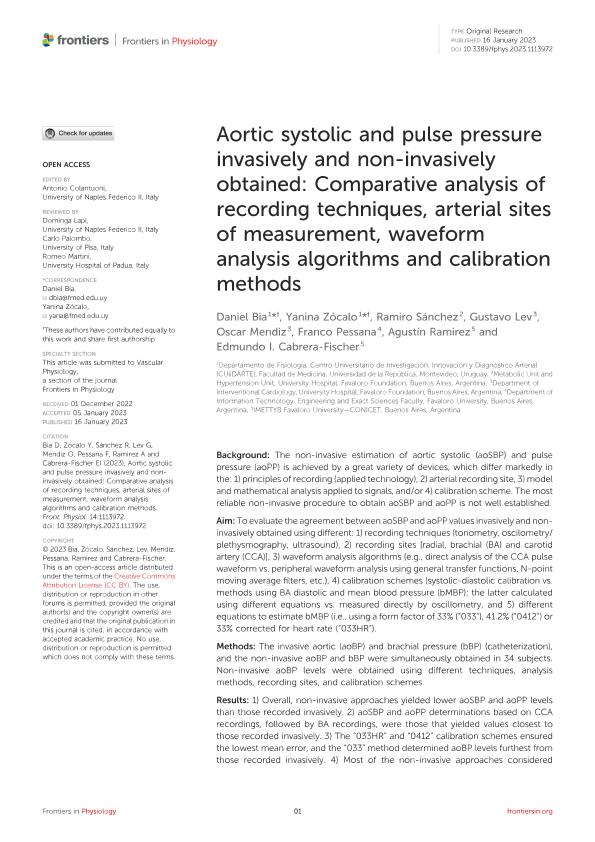Mostrar el registro sencillo del ítem
dc.contributor.author
Bia, Daniel
dc.contributor.author
Zócalo, Yanina
dc.contributor.author
Sánchez, Ramiro
dc.contributor.author
Lev, Gustavo
dc.contributor.author
Mendiz, Oscar
dc.contributor.author
Pessana, Franco Martin

dc.contributor.author
Ramírez, Agustín José

dc.contributor.author
Cabrera Fischer, Edmundo Ignacio

dc.date.available
2023-12-01T15:57:53Z
dc.date.issued
2023-01
dc.identifier.citation
Bia, Daniel; Zócalo, Yanina; Sánchez, Ramiro; Lev, Gustavo; Mendiz, Oscar; et al.; Aortic systolic and pulse pressure invasively and non-invasively obtained: Comparative analysis of recording techniques, arterial sites of measurement, waveform analysis algorithms and calibration methods; Frontiers Media; Frontiers in Physiology; 14; 1113972; 1-2023; 1-21
dc.identifier.uri
http://hdl.handle.net/11336/219040
dc.description.abstract
Background: The non-invasive estimation of aortic systolic (aoSBP) and pulse pressure (aoPP) is achieved by a great variety of devices, which differ markedly in the: 1) principles of recording (applied technology), 2) arterial recording site, 3) model and mathematical analysis applied to signals, and/or 4) calibration scheme. The most reliable non-invasive procedure to obtain aoSBP and aoPP is not well established. Aim: To evaluate the agreement between aoSBP and aoPP values invasively and non-invasively obtained using different: 1) recording techniques (tonometry, oscilometry/plethysmography, ultrasound), 2) recording sites [radial, brachial (BA) and carotid artery (CCA)], 3) waveform analysis algorithms (e.g., direct analysis of the CCA pulse waveform vs. peripheral waveform analysis using general transfer functions, N-point moving average filters, etc.), 4) calibration schemes (systolic-diastolic calibration vs. methods using BA diastolic and mean blood pressure (bMBP); the latter calculated using different equations vs. measured directly by oscillometry, and 5) different equations to estimate bMBP (i.e., using a form factor of 33% (“033”), 41.2% (“0412”) or 33% corrected for heart rate (“033HR”). Methods: The invasive aortic (aoBP) and brachial pressure (bBP) (catheterization), and the non-invasive aoBP and bBP were simultaneously obtained in 34 subjects. Non-invasive aoBP levels were obtained using different techniques, analysis methods, recording sites, and calibration schemes. Results: 1) Overall, non-invasive approaches yielded lower aoSBP and aoPP levels than those recorded invasively. 2) aoSBP and aoPP determinations based on CCA recordings, followed by BA recordings, were those that yielded values closest to those recorded invasively. 3) The “033HR” and “0412” calibration schemes ensured the lowest mean error, and the “033” method determined aoBP levels furthest from those recorded invasively. 4) Most of the non-invasive approaches considered overestimated and underestimated aoSBP at low (i.e., 80 mmHg) and high (i.e., 180 mmHg) invasive aoSBP values, respectively. 5) The higher the invasively measured aoPP, the higher the level of underestimation provided by the non-invasive methods. Conclusion: The recording method and site, the mathematical method/model used to quantify aoSBP and aoPP, and to calibrate waveforms, are essential when estimating aoBP. Our study strongly emphasizes the need for methodological transparency and consensus for the non-invasive aoBP assessment.
dc.format
application/pdf
dc.language.iso
eng
dc.publisher
Frontiers Media

dc.rights
info:eu-repo/semantics/openAccess
dc.rights.uri
https://creativecommons.org/licenses/by/2.5/ar/
dc.subject
APPLANATION TONOMETRY
dc.subject
CALIBRATION
dc.subject
CATHETERISM
dc.subject
CENTRAL AORTIC BLOOD PRESSURE
dc.subject
INVASIVE RECORDS
dc.subject
NON-INVASIVE RECORDS
dc.subject
OSCILLOMETRY
dc.subject
VASCULAR ULTRASOUND
dc.subject.classification
Otras Medicina Básica

dc.subject.classification
Medicina Básica

dc.subject.classification
CIENCIAS MÉDICAS Y DE LA SALUD

dc.title
Aortic systolic and pulse pressure invasively and non-invasively obtained: Comparative analysis of recording techniques, arterial sites of measurement, waveform analysis algorithms and calibration methods
dc.type
info:eu-repo/semantics/article
dc.type
info:ar-repo/semantics/artículo
dc.type
info:eu-repo/semantics/publishedVersion
dc.date.updated
2023-11-29T13:19:41Z
dc.identifier.eissn
1664-042X
dc.journal.volume
14
dc.journal.number
1113972
dc.journal.pagination
1-21
dc.journal.pais
Suiza

dc.journal.ciudad
Lausana
dc.description.fil
Fil: Bia, Daniel. Universidad de la República; Uruguay
dc.description.fil
Fil: Zócalo, Yanina. Universidad de la República; Uruguay
dc.description.fil
Fil: Sánchez, Ramiro. Fundación Favaloro; Argentina
dc.description.fil
Fil: Lev, Gustavo. Fundación Favaloro; Argentina
dc.description.fil
Fil: Mendiz, Oscar. Fundación Favaloro; Argentina
dc.description.fil
Fil: Pessana, Franco Martin. Universidad Favaloro; Argentina
dc.description.fil
Fil: Ramírez, Agustín José. Consejo Nacional de Investigaciones Científicas y Técnicas. Oficina de Coordinación Administrativa Houssay. Instituto de Medicina Traslacional, Trasplante y Bioingeniería. Fundación Favaloro. Instituto de Medicina Traslacional, Trasplante y Bioingeniería; Argentina
dc.description.fil
Fil: Cabrera Fischer, Edmundo Ignacio. Consejo Nacional de Investigaciones Científicas y Técnicas. Oficina de Coordinación Administrativa Houssay. Instituto de Medicina Traslacional, Trasplante y Bioingeniería. Fundación Favaloro. Instituto de Medicina Traslacional, Trasplante y Bioingeniería; Argentina
dc.journal.title
Frontiers in Physiology
dc.relation.alternativeid
info:eu-repo/semantics/altIdentifier/doi/http://dx.doi.org/10.3389/fphys.2023.1113972
dc.relation.alternativeid
info:eu-repo/semantics/altIdentifier/url/https://www.frontiersin.org/articles/10.3389/fphys.2023.1113972/full
Archivos asociados
